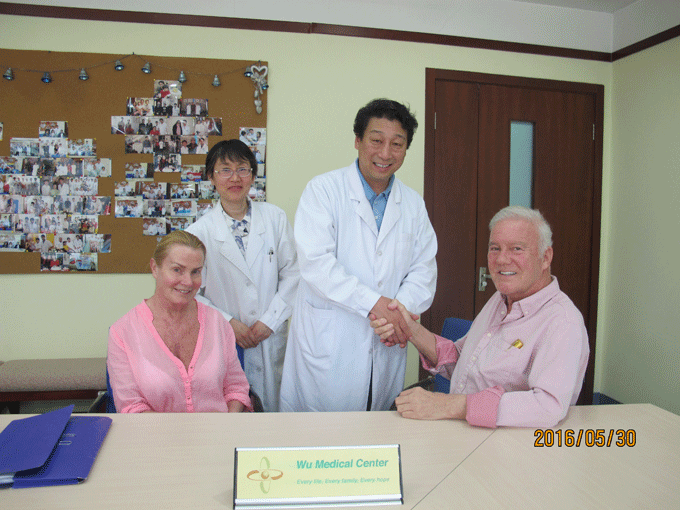Peter Atkins-Motor Neuron Disease-(Britain)-Posted on August 16th, 2016
 Name: Peter Atkins
Name: Peter Atkins
Sex: Male
Nationality: British
Age: 73
Diagnoses: 1. Motor Neuron Disease: Amyotrophic Lateral Sclerosis 2. Coronary Artery Stenosis(Coronary Artery Bypass) 3. Level I A-V block 4. Artbrolithiasis
Date of Admission: May 16, 2016
Treatment hospital/period: Wu Medical Center/13 days
Before treatment:
Peter found it difficult to move his right shoulder joint 8 months ago, so he decided to have shoulder joint surgery done. After he had his shoulder examined, the doctor found he had muscle atrophy in the shoulder. Progressively, his right upper limb became harder to move, accompanied with the muscle atrophy. He had an electromyography done and the results showed damage to the nervous system. Peter was diagnosed with amyotrophic lateral sclerosis. His disease became progressively worse, his left shoulder and upper limb were weakened and accompanied with muscle atrophy. The thorax muscle, shoulder muscle, back muscle, and the muscles of both upper limbs had paroxysmal fasciculation. His lower limbs are normal now, he is able to stand and walk, but when he sits up from a lying position, the posture is abnormal. It is really difficult for him to move his upper limbs and shoulders. He needs help to get dressed, eat and wash his face. He is able to take care of himself basically.
His sleep routine and diet are normal. The bowel movements and urination are normal.
Admission PE:
Bp: 108/66mmHg, Hr: 67/min. Br: 18/min. Temperature: 36.0 degrees. Height: 180cms, weight: 81kg. Peter’s body type and nutritional situation were normal. There were no yellow stains or petechia on his skin. The color of his lips was normal. There was no pharyngeal congestion. The tonsils were not enlarged. His bony thorax was symmetrical. The respiratory sounds in both lungs were clear, with no dry or moist rales. There was no precordial prominence. The rhythm of the heartbeats was powerful and regular. There was a slight murmur in the aortic valve, there was no obvious murmur in the other valves. The abdomen was soft and flat with no pressing pain or rebound tenderness. There was no mass. The liver and spleen were normal. The shifting dullness was negative. There was spinal physiological curvature. There was no edema in the lower limbs. Cardiogram result: Level I A-V block.
Nervous System Examination:
Peter Atkins was alert and he was in good spirits. He was able to speak clearly. His memory, calculation abilities and orientation were normal. Both pupils were equal in size and round, their diameter was 3 mms. Both eyes had sensitive responses to light stimuli. Both eyeballs could move freely. There was no nystagmus. The nasolabial fold and forehead wrinkle pattern were symmetrical. The tongue was centered in the oral cavity. There was no tooth deflection. He was able to touch the inside of his cheeks with his tongue normally. He was able to expand his cheeks well. He chewed strongly and both soft palates could be raised powerfully. He was able to close his eyes normally.. The neck was soft, and he was able to flexibly turn his neck around and shrug his shoulders powerfully. It was difficult for him to move his shoulders. He was able to raise his arms to his nose. The abductor muscle power of the upper limbs was at level 3, the adductor muscle power of the upper limbs was at level 4. The abductor and adductor muscle power of the forearms was at level 4. The gripping strength of the hands was at level 4. The muscle power of the lower limbs was at level 5. The muscle tension of the upper limbs was a little lower than normal. The muscle tension of the lower limbs was normal. There was muscle atrophy in the shoulder girdle, upper limbs, big thenar, hypothenar and interosseous muscles. There was fasciculation in the upper limbs, chest and trunk. The bilateral biceps reflex, radial periosteal reflex and triceps reflex were abnormal. The patella tendon reflex was normal. The Achilles tendon reflex was abnormal. The bilateral Babinski sign was negative. Peter was not able to do the finger-to-nose test because of his shoulder problems. He was not able to complete the rapid rotation test slowly, his right little finger was not able to complete the finger-to-finger test, but the other fingers slowly completed the test. The heel-knee-tibia test was completed normally. The meningeal irritation sign was negative.
Treatment:
Peter was diagnosed with 1. Motor Neuron Disease: Amyotrophic Lateral Sclerosis 2. Coronary Artery Stenosis (Coronary Artery Bypass) 3. Level I A-V block. He received 3 neural stem cell injections and 3 mesenchymal stem cell injections to repair his damaged nerves, regenerate new nerve cells, activate the stem cells in his body, improve his blood circulation and nourish the neurons. Peter was put on a non-invasive ventilator to help him breath. We also gave him daily physical rehabilitation.
Post-treatment:
After 13 days of treatment, the neurons functioned better, Peter had better exercise tolerance, his upper limbs and fingers were flexible. He had less fasciculations. He moved his shoulders better. He was able to raise his hands to his eyebrows. His right little finger was able to do the finger-to-finger test. During the treatment, he felt pain in his left ankle at first, and then the pain extended throughout his left foot. The doctor considered the cause to be artbrolithiasis. So he received treatment to control the amount of purine, alklized urine, etc. After this, Peter’s left foot improved and he felt less pain.

(Download the Windows Media Player Firefox Plugin if you are using Firefox browser.
To know more,Please read Using the Windows Media Player plugin with Firefox.)
E-mails:
Date:2016-8-16

